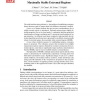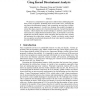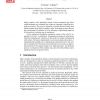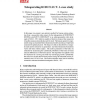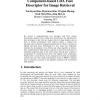BMVC
2002
14 years 2 months ago
2002
A likelihood formulation for human tracking is presented based upon matching feature statistics on the surface of an articulated 3D body model. A benefit of such a formulation ove...
BMVC
2001
14 years 2 months ago
2001
A perceptual approach to generating features for use in indexing and retrieving images is described. Salient regions that immediately attract the eye are colour (textured) regions...
BMVC
2002
14 years 2 months ago
2002
The wide-baseline stereo problem, i.e. the problem of establishing correspondences between a pair of images taken from different viewpoints is studied. A new set of image elements...
BMVC
2001
14 years 2 months ago
2001
We present a comprehensive approach to address three challenging problems in face recognition: modelling faces across multi-views, extracting the non-linear discriminating feature...
BMVC
2002
14 years 2 months ago
2002
Many computer vision algorithms include a robust estimation step where model parameters are computed from a data set containing a significant proportion of outliers. The RANSAC al...
BMVC
2001
14 years 2 months ago
2001
We address the problem of non-rigid motion and correspondence estimation in 3D images in the absense of prior domain information. A generic framework is utilized in which a soluti...
BMVC
2002
14 years 2 months ago
2002
In this paper, we present a non-intrusive method for human motion estimation from a monocular video camera for the teleoperation of ROBONAUT (ROBOtic astroNAUT). ROBONAUT is an an...
BMVC
2002
14 years 2 months ago
2002
This paper presents novel methods for increasing the robustness of visual tracking systems by incorporating information from inertial sensors. We show that more can be achieved th...
BMVC
2002
14 years 2 months ago
2002
This paper investigates the combination of spatial and probabilistic models for reasoning about pedestrian behaviour in visual surveillance systems. Models are learnt by a multi-s...
BMVC
2002
14 years 2 months ago
2002
We present a component-based face descriptor with LDA (Linear Discriminant Analysis) and a simple pose classification. Our algorithm has been developed to deal with face image ret...

